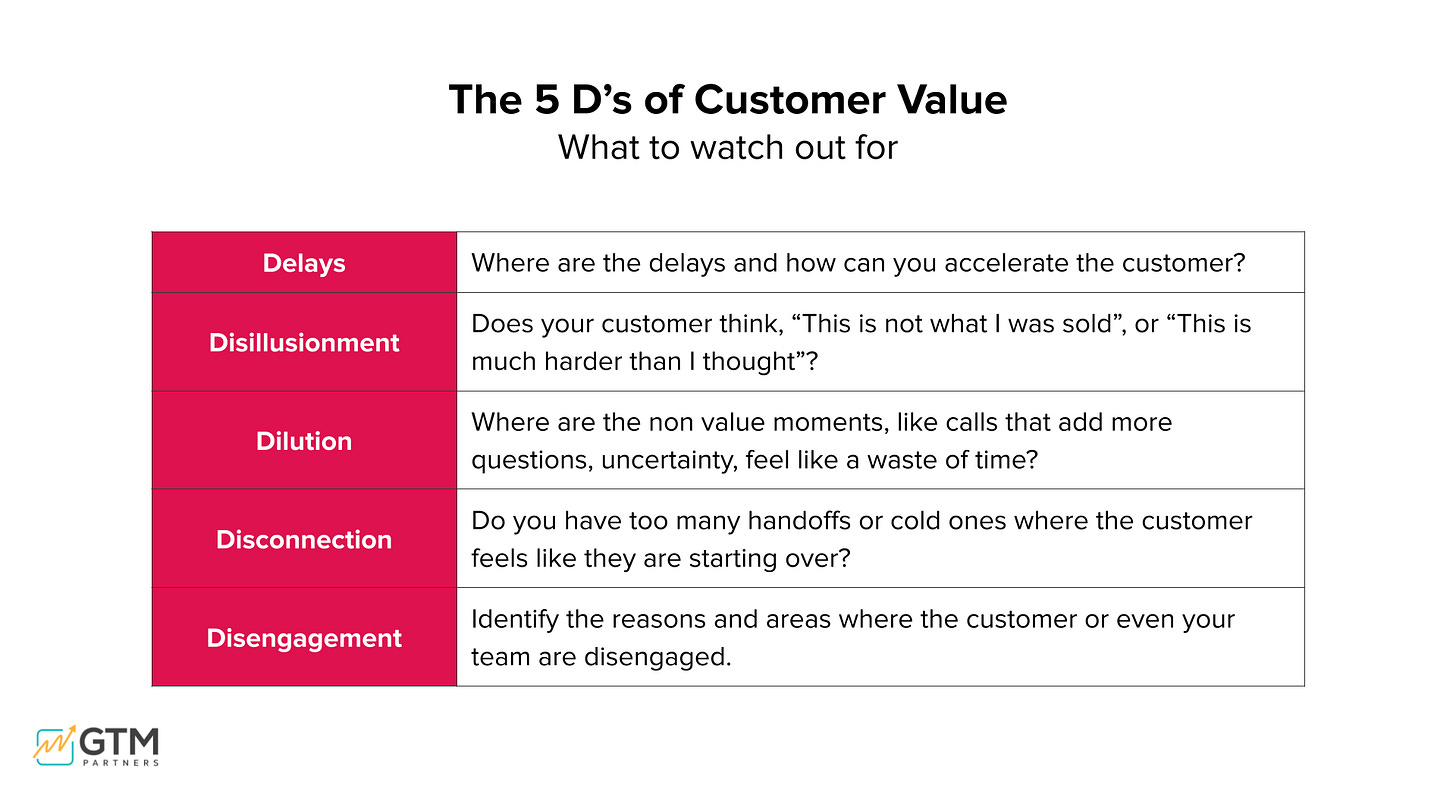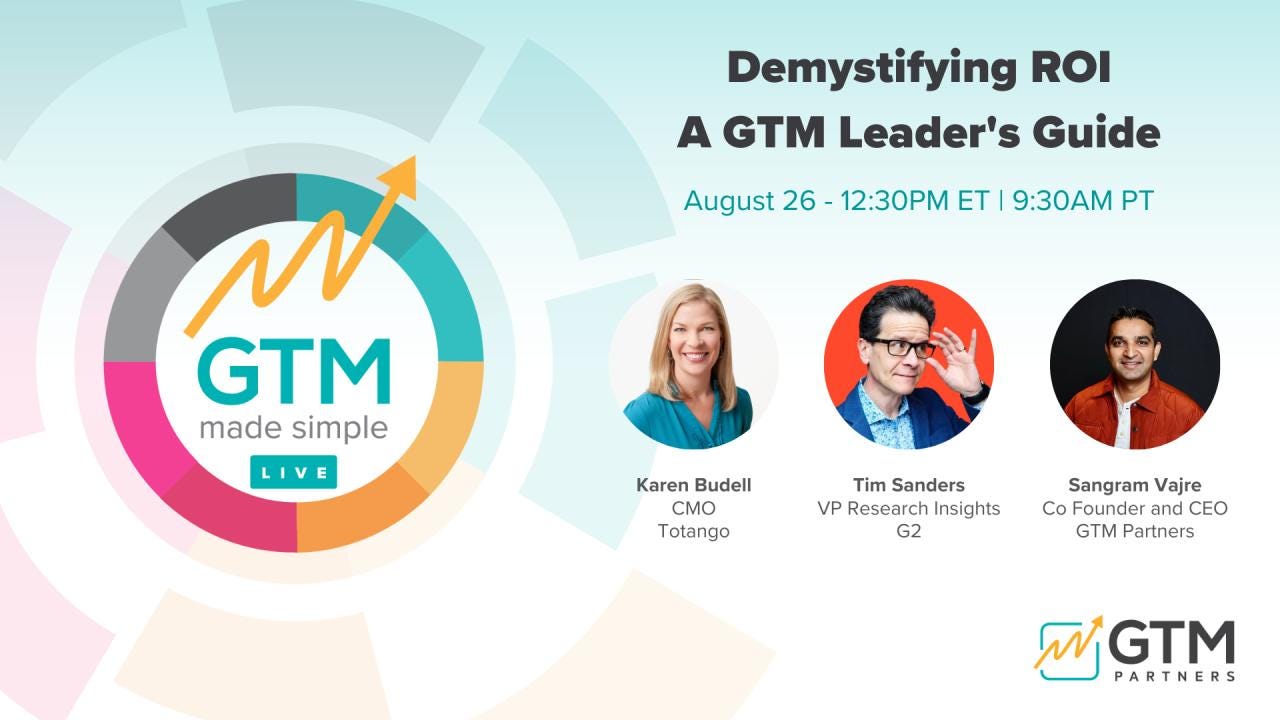Accelerate Customer Time to Value with Customer Value Mapping
Introducing Customer Value Mapping (CVM), a new results-oriented approach that gets customers to ROI faster.
Thanks for being one of more than 100,000 forward-thinking GTM Leaders who subscribe to this weekly research note. We aim to be the go-to for go-to-market, so we appreciate you reading and sharing when you see something you like!
This week’s research note includes:
GTM Research: Customer Value Mapping
Better Together: See you in Atlanta this Wednesday!
ROI Study of the Week: The Importance of Signal-Based Selling with MadKudu
GTM Events: Events you should know about
Exciting News: Welcome GTM Partner Lindsay Cordell!
GTM Made Simple Live! this Tuesday with Karen Budell and Tim Sanders at G2
GTM Research: Accelerating Time to Value with Customer Value Mapping
A weekly deep-dive into new GTM research and insights
We’ve all designed customer journeys, meticulously mapping out each step a customer takes from discovering your brand to making a purchase to renewal and even expansion.
But what if we reframed this journey?
In addition to asking, “How does the customer feel?” and “What is the customer doing?” we should be asking, “How quickly can they see value?”
This subtle shift in perspective can have a profound impact on your go-to-market strategy.
The goal of Customer Value Mapping (CVM) is simple: align every aspect of your customer’s journey with the outcomes they want to achieve, and ensure your entire go-to-market team is working together to deliver that value as quickly as possible.
Customer Time to Value is Pillar 5 in our GTM Operating System.
Step 1: Mapping the As-Is Experience
To begin, gather a cross-functional team that includes representatives from customer success, marketing, sales, and product, as well as data analysts.
Your first task is to map out the current, or "as-is," customer experience—from the initial touchpoint with your brand through to the first renewal cycle.
Use whiteboards or virtual tools like MiroBoard to visually represent this journey.
Document each phase of the buying process, noting key moments such as website visits, sales calls, and onboarding.
Be sure to include the number of handoffs between teams and the average time taken at each stage.
This comprehensive view will help you identify where delays occur and where customers might be getting disillusioned.
Step 2: Identifying and Eliminating the Five D’s
Once you have your as-is map, it’s time to diagnose the problems.
Specifically, look for what we call the Five D’s: Delays, Disillusionment, Dilution, Disconnection, and Disengagement.
Delays: Identify where the customer experience could be accelerated. Mark any significant delays in the process and prioritize them for improvement.
Disillusionment: This occurs when there’s a disconnect between what was promised and what is delivered. Ensure that your sales team is not overselling features that aren’t yet fully functional or available.
Dilution: Avoid non-value moments—those activities that waste the customer’s time without contributing to their success. For example, if customers need to complete a detailed spreadsheet, explain why this step is necessary to achieve their goals.
Disconnection: These are the cold handoffs between teams. Count the number of handoffs and assess if they are necessary. If the average is seven, ask yourself if that’s too high and what can be done to improve the process.
Disengagement: When customers or your team become unresponsive, it’s a red flag. Monitor engagement levels and take steps to re-engage where needed.
Step 3: Designing the To-Be Experience
With the problems identified, it’s time to design a future, or “to-be,” experience. This is where creativity and collaboration come into play.
Use sticky notes or digital tools to brainstorm solutions with your team. Focus on ideas that have a high impact on customer value and are feasible to implement quickly.
Visualize these ideas on an impact vs. feasibility chart.
Prioritize those that land in the top-right quadrant—high impact and highly feasible. These should be your immediate action items, your A-list priorities.
The B-list items can follow, while the C-list can be revisited later.
Step 4: Creating a Go-to-Market Roadmap
By the end of this process, you’ve done more than just improve customer time to value—you’ve created a comprehensive go-to-market roadmap.
This roadmap is aligned across teams, eliminating debates about priorities and ensuring everyone is on the same page.
Assign owners to each action item, set deadlines, and start executing.
Many companies find that they can implement several of these improvements within just a few weeks, delivering value to customers faster than ever before.
Transform the Customer Experience
Customer Value Mapping is not just about enhancing the customer experience—it’s about transforming it.
By focusing on time to value, you can create a more efficient, aligned, and impactful go-to-market strategy that delivers results both for your customers and your business.
Do you need help with your GTM strategy and execution?
GTM Partners works with B2B companies in the following ways:
GTM Audit and Plan: We assess your current GTM challenges and opportunities, provide a GTM Score, and offer a plan for identifying and prioritizing your biggest GTM challenges.
1:1 Advisory: Our 1-on-1 advisory provides coaching for GTM leaders who need help elevating their strategy. Through regular calls, you'll work with our analysts to refine your GTM and achieve personal and professional goals.
GTM Team Advisory: We work with your entire GTM team to execute your plan using our proprietary GTM Operating System and the frameworks we’ve built to accelerate your growth. We can do this on a project basis to address specific needs or help you through a total GTM transformation.
We’d love to chat more about what you need and how we can help.
GTM is Better Together: See You in ATL on Wednesday!
“GTM is Better Together” is a revolutionary new vision that the future of GTM is better together with unified teams, tech, and trust. This is a weekly feature where we will share the latest announcements related to this important initiative.
We are really excited to see many of you this coming Wednesday! There is still time to request a pair of tickets for any of our upcoming summits.
ATLANTA: August 28
BOSTON: September 10
NYC: October 22
SAN FRANCISCO: November 20
ROI Study of the Week: MadKudu
GTM Partners’ ROI studies are third-party validated assessments of Go-to-Market vendor solutions that are primarily focused on how to get the most out of an investment in technology.
Centered around use cases (as opposed to stack ranking vendors), these guides are intended to provide readers with a data-driven analysis of what problems the solution is intended to solve and how well it delivers on those promises.
To learn more about our ROI studies, book a meeting here.
The Importance of Signal-Based Selling
With longer sales cycles, shrinking budgets, bigger buying committees, and more competition for attention, B2B sales teams need a different approach to generate demand and focus efforts.
Signal-based selling empowers companies to concentrate time and resources on the most promising leads at the right time in their journey, personalize outreach, and align their sales and marketing efforts to drive high-quality pipeline.
By leveraging data signals from potential customers' behaviors and interactions, B2B companies can tailor their outreach and engagement strategies, leading to more pipeline and higher conversion rates.
About MadKudu
MadKudu helps SaaS companies identify, qualify, and engage high-value prospects throughout the buyer journey so that sales teams focus their efforts on leads that are more likely to convert and generate significant revenue.
Many business leaders would love to know who is checking out their competition on social media, which recently closed opportunities have been visiting the website, which users are experimenting with product features that correlate highly with an upsell.
MadKudu is able to identify those accounts through first-party data sources (web activity, product usage) augmented with third-party intent and data enrichment (technographics, firmographics, anonymous web activity, social activity). MadKudu then provides salespeople with literal playbooks to run based on what the signal is showing.
MadKudu integrates well with your existing GTM platforms and tools, providing actionable insights and enabling automated, personalized marketing and sales activities across your tech stack.
GTM Events
A list of upcoming events of interest to GTM professionals
August 28, Atlanta: GTM is Better Together
September 10, Boston: GTM is Better Together
September 18-20, Boston: INBOUND 2024
October 14-16, Austin, TX: Pavilion’s GTM 2024 (use code GTMPARTNERS20 for 20% off your ticket)
October 16, Austin: GTM Made Simple Roadshow
October 22, NYC: GTM is Better Together
November 20, San Francisco: GTM is Better Together
Exciting News!
Drumroll please . . .
We are excited to announce that Lindsay Cordell is officially a Partner with GTM Partners!
Over the last two years, Lindsay has led GTM advisory services and has been the brain child behind much of the GTM Operating System as well as so many of the frameworks and processes that hundreds of companies are using today.
Lindsay is a tireless champion of advancing GTM strategies and always pushing for more rigor, collaboration, and discipline within and across GTM functions. She is in many ways the heart and soul behind the work we do every day.
Congratulations to Lindsay!
GTM Made Simple Live! TODAY at 12:30 p.m. EST
Join our co-founder and CEO Sangram Vajre every week on LinkedIn at 12:30 ET for a deep dive into one of our research topics.
Today, August 25 at 12:30, Sangram will be joined by Karen Budell, CMO of Totango + Catalyst and Tim Sanders, VP of Research Insights at G2 to talk about transforming raw data into ROI stories that really connect with prospects.
Join Sangram today on LinkedIn, or register for the weekly series.
Hope to see many of you on the road this fall!
Love,
The GTM Partners Team






